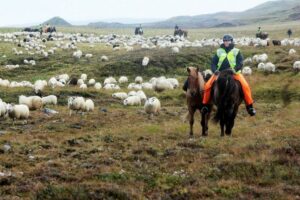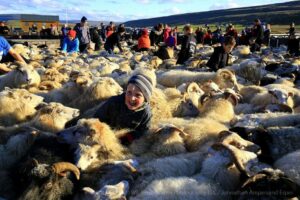While driving along the windswept countryside roads outside around Iceland , one might run into the frequent meandering of sheep on the roads. With a large population of sheep that can be found in Iceland, it comes as no surprise that the island has a rooted, annual tradition that involves – you guessed it – sheep!
After roaming the countryside during the warm summer months, the wooly sheep – approximately 800,000 of them, more than twice the human population – are brought inside for winter. Réttir – the annual sheep round-up takes place over a few days and is led by farmers who invite friends, family and tourists alike to take part in the old tradition. Some 150 farms participate in Réttir.
This round up is only available for experienced horse riders as the herding takes place in steep mountain ranges for which you will be riding the famously nimble Icelandic horse. Traditionally, the event is followed by a celebration consisting of singing and eating with the surrounding neighbors, family and friends before the sorting of sheep ownership begins.
Iceland’s sheep freely roam the mountains and fjords during the summer, basking in the long sun-filled days, while seasoning and fattening themselves with lush lichen, moss and grass.
The sheep are rounded up in a wooden sheepfold, consisting of an inner and outer circle with several compartments between the two. Each compartment is assigned to a particular farm for their sheep. Each farm has its own earmark symbol and the farmers and friends herd the sheep into separate pens.
During this time, sheep are trotting about, baaing and bucking, while carefully being sorted. Visitors can see farmers and children mounting the backs of ewes and rams to guide them to the relevant pen. After all the sheep are sorted, the farmers and guests share cups of coffee and sometimes something a bit stronger ????.
Icelandic lamb is used for everything from traditional meat soup, lamb chops, hot dogs to Icelandic specialties including slátur (liver sausage) and svið (singed lamb heads). Nearly every part of the animal is used in some manner, either as wool garments or as blood pudding.
Sheep have been and still are the lifeblood of the tiny North Atlantic island of 330,000 people, not just for nourishment and a source of income, but for their thick and warm wool. Icelandic sheep are a unique breed as the purity of the strain has been protected and preserved by centuries of isolation. Indeed, the breed has evolved over 1,100 years of surviving in a sub-Arctic climate producing long and tough outer fibers and soft and fine inner fibers. Colors of the breed vary. There are over 30 natural sheep colors, including yellow, black, and brown, but most Icelandic sheep are white. The bright white coats can be seen dotting the countryside in the autumn.
The natural benefits of the wool are unique to the breed as well. Icelandic sheep are known for having warm, lightweight, breathable and water repellant wool. Iceland’s wildly popular woolen sweaters, called lopapeysur, can be seen on tourists and locals strutting the streets of downtown Reykjavik as well as in the countryside.
List of Réttir events Iceland 2022: Fjár- og stóðréttir 2022 – Bændablaðið (bbl.is)
Hope this reading enlightened you, caroline@nonnitravel.is




